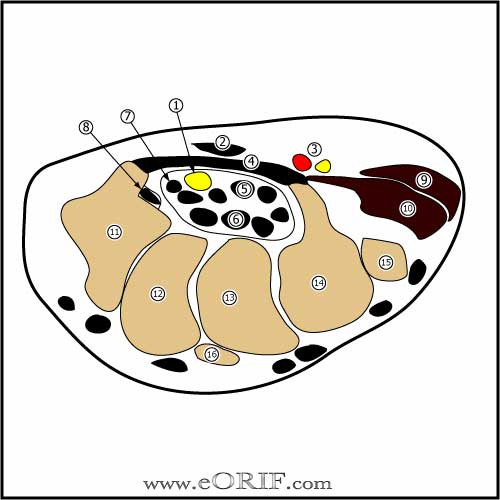|

|
synonyms:Carpal Tunnel Release, CTR
Carpal Tunnel Release CPT
Carpal Tunnel Release Indications
- Carpal tunnel syndrome
- Carpal tunnel syndrome in elderly patients
Carpal Tunnel Release Contraindications
- Infection
- Medically unstable patient
Carpal Tunnel Release Alternatives
- Non-operative treatment (activity modifications, splints, injections).
Carpal Tunnel Release Pre-op Planning
- No proven benefit to internal neurolsys of the median nerve or flexor tendon tenosynovectomy.
Carpal Tunnel Release Technique
- Sign operative site.
- Pre-operative antibiotics
- Bier block / regional block.
- Supine position. All bony prominences well padded.
- tourniquet
- Prep and drape in standard sterile fashion.
- expected location of motor branch of median nerve marked by intersection of a line drawn along the distal aspect of the abducted thumb to a point 1cm distal to the pisiform, with line dropped proximally from the ulnar border of the index finger
- incision from volar wrist crease just ulnar to palmaris longus in line with ring finger along the curved thenar crease.
- dissection under 2.5/3.5 loop magnification
- watch for palmar cutaneous nerve branches, and motor branch of median nerve
- split fibers of palmar fascia
- identify thickened proximal edge of transverse carpal ligament.
- distal end exposed with spreading dissection, identify any aberrant nerve branches
- gentle free flexor tenosynovium from undersurface of transverse carpal ligament.
- split transverse carpal ligament the length of the carpal canal from proximal to distal, paralleling the ulnar border of the median nerve
- explore and idenfiy motor branch ensuring it has not been injured.
- Irrigate.
- palmar fascia closed with 4-0 nonabsorbable suture
- Close in layers.
Carpal Tunnel Release Complications
- Pillar pain (most common; <10%)
- Recurrence
- Infection
- CRPS
- We discussed the risks of carpal tunnel release including but not limited to: incomplete relief of pain, incomplete return of function, persistent numbness, palmar hypersensitivity, proximal pain, nerve or vascular injury, wound dehiscence, infection and the risks of anesthesia including heart attack, stroke and death.
Carpal Tunnel Release Follow-up care
- Post-op: Volar splint, NWB
- CTR Post-op Pain management: Narcotic or Tramadol supplemented with NSAIDS and/or tylenol. Mean tramadol consumption of 3.3 pills for 1.8 days; mean opioid consumption of 4.9 pills for 2.3 days (Miller A, Hand 2017;12:541).
- 7-10 Days: Remove sutures, consider night time splinting. Start gentle ROM exercises
- Light Duty for 3-6 weeks.
- 6 Weeks: Begin strengthening exercises. MMI 6-12 weeks)
- 3 Months:Return to full activities / sport
Carpal Tunnel Release Outcomes
Carpal Tunnel Release Review References
Greens Hand Surgery |

